Chris Conner, the director of homelessness systems strategy for Denver's HOST, sat in his pickup truck at 4 a.m. this morning outside the Webb Building, helping Denver's volunteers. He has participated in the Point in Time count for ten years now.
"The Point in Time isn't just Denver and the seven counties. This is happening across the nation," he says. "All that gives Washington a picture of one night a year and the chance to ask 'What did homelessness look like?'"
"The Point in Time isn't just Denver and the seven counties. This is happening across the nation," he says. "All that gives Washington a picture of one night a year and the chance to ask 'What did homelessness look like?'"
Last year's Point in Time count found that the metro area has more than 9,000 homeless individuals. About 6,300 of them were in shelters; the other 2,700 were out on the streets when the count was conducted. This was a 32 percent increase in the number of homeless people across the metro area compared with 2022.
Nearly 5,800 of the people counted in 2023 were in Denver. No other county in the metro area tallied more than 1,000, but Adams County had more than 900 and Boulder County more than 800.
The City of Denver alone accounts for 1 percent of the nation's homeless population of roughly 653,000 people, according to the 2023 Point in Time count. "I think about that a lot," Conner says. "For every person we might see on a street corner in Denver, there are 99 people standing behind them across the country who are also experiencing homelessness."
Sheltered homeless, or people staying in overnight shelters on the night of the count, are recorded through the Homeless Management Information System, a regional database.
The seven counties in metro Denver report the numbers gathered during the Point in Time count for both sheltered and unsheltered homeless to the Metro Denver Homeless Initiative, which manages the region's continuum of care, a system of coordinated homeless services mandated by HUD.
Nearly 5,800 of the people counted in 2023 were in Denver. No other county in the metro area tallied more than 1,000, but Adams County had more than 900 and Boulder County more than 800.
The City of Denver alone accounts for 1 percent of the nation's homeless population of roughly 653,000 people, according to the 2023 Point in Time count. "I think about that a lot," Conner says. "For every person we might see on a street corner in Denver, there are 99 people standing behind them across the country who are also experiencing homelessness."
Sheltered homeless, or people staying in overnight shelters on the night of the count, are recorded through the Homeless Management Information System, a regional database.
The seven counties in metro Denver report the numbers gathered during the Point in Time count for both sheltered and unsheltered homeless to the Metro Denver Homeless Initiative, which manages the region's continuum of care, a system of coordinated homeless services mandated by HUD.
On Tuesday morning, Denver's Point in Time counters only took part in observation — a tally of people seen living outside. After observation, Denver's volunteers will follow up with a survey that asks questions about how they became homeless, their medical history and other personal information.
 MDHI reports the survey results alongside data collected year-round from other sources in its annual State of Homelessness report, which "is going to tell a different story than just the Point in Time count," Conner says. "That's when you get into seeing that there's tens of thousands of people who have access to homeless services throughout the year."
MDHI reports the survey results alongside data collected year-round from other sources in its annual State of Homelessness report, which "is going to tell a different story than just the Point in Time count," Conner says. "That's when you get into seeing that there's tens of thousands of people who have access to homeless services throughout the year."
HUD gives counties ten days to conduct the survey, so the Point in Time count will continue in Denver through the week. The first night of observations, however, is known as "Point in Time night," and that's when Denver relied on 46 volunteers, all city employees — mostly with HOST — who signed on to drive or walk through the city to count homeless residents.
Arapahoe County, which includes Littleton and part of Aurora, relied on thirty volunteers to hit the streets and rural areas. The county also had a handful of fixed locations where homeless people walked in, took the Point in Time survey and were counted as homeless.
"We learned that there are many places where people feel safe," says Cameron Shropshire, the housing and homeless program administrator for Arapahoe County. "So the fixed locations help with bringing people in."
Shropshire has been doing the Point in Time count for ten years, too, but he still wakes up on the day of the count "excited and anxious about it every year," he says. "It's something that we know is important, so between October and January, we're all focused on the Point in Time count."
One difference this year, he notes, is that it was warmer than usual. "When the weather is really bad, people tend to seek shelter, and we can count those shelter numbers," he says.


Chris Conner, the director of homelessnessness systems strategy for Denver, sits in his vehicle, from which he'll manage the Point in Time count volunteers.
Bennito L. Kelty
The State of Homelessness 2023 report — published on Thursday, January 18 — found that 94 percent of the metro area's homeless residents didn't choose to be in their situation, that 88 percent were from Colorado rather than another state, and that 22 percent of homeless were Black even though only 6 percent of the region's population is Black. It also determined that 30,000 people accessed homeless services in the metro area from July 1, 2022, to June 30, 2023.
HUD gives counties ten days to conduct the survey, so the Point in Time count will continue in Denver through the week. The first night of observations, however, is known as "Point in Time night," and that's when Denver relied on 46 volunteers, all city employees — mostly with HOST — who signed on to drive or walk through the city to count homeless residents.
HOST split its volunteers into twenty teams of two. Each team was responsible for counting in one of twenty areas drawn up to divide the city into more manageable chunks. None of those teams had to worry about Denver International Airport, where Conner did the count himself.
Another five teams were available as backup. Denver park rangers took on the duty of counting homeless residents at the parks and trail systems. Denver Street Enforcement, a civilian Public Safety unit, counted residents living in vehicles, including RVs.
Another five teams were available as backup. Denver park rangers took on the duty of counting homeless residents at the parks and trail systems. Denver Street Enforcement, a civilian Public Safety unit, counted residents living in vehicles, including RVs.
"We learned that there are many places where people feel safe," says Cameron Shropshire, the housing and homeless program administrator for Arapahoe County. "So the fixed locations help with bringing people in."
Shropshire has been doing the Point in Time count for ten years, too, but he still wakes up on the day of the count "excited and anxious about it every year," he says. "It's something that we know is important, so between October and January, we're all focused on the Point in Time count."
One difference this year, he notes, is that it was warmer than usual. "When the weather is really bad, people tend to seek shelter, and we can count those shelter numbers," he says.
HUD determines when the count takes place, always late in January. Conner thinks the agency prefers cold nights, so that it can look at "When all the push factors are in place to go inside, what does homelessness look like?"

Cameron Shropshire with Arapahoe County stands in GraceFull Cafe in Littleton, where homeless residents can stop by to participate in the Point in Time count.
Bennito L. Kelty
Jefferson County, which includes Lakewood and Golden, relied on 135 volunteers whose ranks included residents and employees for the county as well as the City of Lakewood and Recovery Works, a Lakewood-based nonprofit that serves the homeless.
Molly Hanson, the development director of Recovery Works, thinks Jefferson County's corps of volunteers is unique. "It's an unusual element that we are using so many volunteers," she says. "Plus, so many of our volunteers are guests of Recovery Works; they themselves are unhoused or have that lived experience."
Lauren Bernstein, a community development specialist for Jefferson County who has a decade of experience doing the count, says that having volunteers who have been homeless is helpful when it comes to asking the "invasive" survey questions. "You're meeting someone possibly for the first time," she notes, "so it really helps to have compassionate and knowledgeable volunteers to have this conversation."
Molly Hanson, the development director of Recovery Works, thinks Jefferson County's corps of volunteers is unique. "It's an unusual element that we are using so many volunteers," she says. "Plus, so many of our volunteers are guests of Recovery Works; they themselves are unhoused or have that lived experience."
Lauren Bernstein, a community development specialist for Jefferson County who has a decade of experience doing the count, says that having volunteers who have been homeless is helpful when it comes to asking the "invasive" survey questions. "You're meeting someone possibly for the first time," she notes, "so it really helps to have compassionate and knowledgeable volunteers to have this conversation."
Jefferson County started its count on Monday night and opened the Recovery Works Navigation Center, at 8000 West Colfax in Lakewood, as a place where homeless individuals could gather. The county offered food, haircuts and vaccinations at the navigation center in order to attract people.
"We are expecting the numbers to go up" in Jefferson County's homeless population, Bernstein says, "just because we've seen the need increase throughout the year." But like Shropshire, she admits, "We don't know how the warm weather will play into this" as "more people move around."
"We are expecting the numbers to go up" in Jefferson County's homeless population, Bernstein says, "just because we've seen the need increase throughout the year." But like Shropshire, she admits, "We don't know how the warm weather will play into this" as "more people move around."
Conner also thinks the warmer weather "will impact whether people come inside." But he believes a bigger impact will come from Mayor Mike Johnston's House1000 plan, which the city reports succeeded in moving about 1,200 homeless individuals indoors.
"What I hope would be seen with unsheltered homelessness here is that we're seeing the impact of House1000 and folks being moved off the streets, and that having those 1,200 people inside makes a difference in the end count," Conner says. "House1000 is going to show its impact downtown. That's where the largest encampments were."
Conner says he is unsure how Denver's count will be affected by the influx of migrants living in shelters or out on the streets, however. About 4,400 migrants were living in ten shelters throughout the city as of Tuesday, January 23.
"That's part of what Point in Time will teach us. There's all kinds of potential. Do we see more Spanish-speaking folks on the survey effort?" Conner asks. "We have had some large, pretty salient encampments that were migrant-focused, but are we going to find smaller encampments of migrants? One of the values of seeing everything that's happening during the six-hour period is what we might learn about what's going on out there.'"
The city's migrant response system doesn't report data to the Homeless Management Information Service as shelters do, so Denver reports the number of migrants to MDHI through a separate database. Conner will have to go to each of the ten migrant shelters to conduct surveys.
Conner says he is unsure how Denver's count will be affected by the influx of migrants living in shelters or out on the streets, however. About 4,400 migrants were living in ten shelters throughout the city as of Tuesday, January 23.
"That's part of what Point in Time will teach us. There's all kinds of potential. Do we see more Spanish-speaking folks on the survey effort?" Conner asks. "We have had some large, pretty salient encampments that were migrant-focused, but are we going to find smaller encampments of migrants? One of the values of seeing everything that's happening during the six-hour period is what we might learn about what's going on out there.'"
The city's migrant response system doesn't report data to the Homeless Management Information Service as shelters do, so Denver reports the number of migrants to MDHI through a separate database. Conner will have to go to each of the ten migrant shelters to conduct surveys.
And even with the best efforts, the Point in Time count is never pinpoint-accurate. "We know that we're not going to catch everyone," Shropshire acknowledges.
"Point in Time is always going to be an undercount," Conner says. "There's going to be someone tonight that we're just not going to have eyes on and we're not going to be able to survey."












